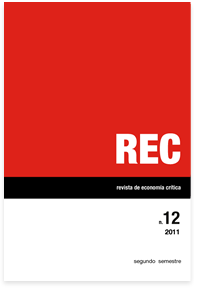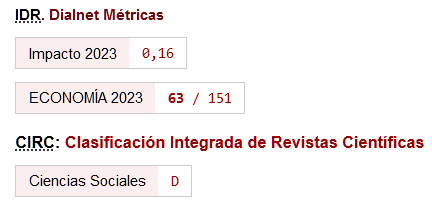¿Qué preocupa a los gobiernos, la brecha de producción o el PIB?
Palabras clave:
Política fiscal, Estabilización del ciclo, MacroeconomíaResumen
Los indicadores sobre la posición cíclica de una economía son de enorme importancia para la ejecución y el análisis de la política fiscal, porque es dicha posición la que condiciona su respuesta.Tanto en los trabajos académicos como en los organismos internacionales se identifica una recesión a partir de la posición cíclica de la economía según la brecha de producción o output-gap.Ahora bien, ¿es realmente el output-gap la variable sobre la cual toman sus decisiones fiscales los poderes públicos? o ¿será más bien la variación del PIB?. Este es un asunto pertinente por cuanto la intencionalidad estabilizadora de las decisiones adoptadas puede ser distinta si se basa en una u otra variable.
Descargas
Citas
Afonso, A. y Hauptmeier, S. (2009): "Fiscal behaviour in the European Union. Rules, fiscal decentralization and government indebtness", European Central Bank Working Paper Series, 1054. https://doi.org/10.2139/ssrn.1399284
Banco Central Europeo (2000): "Crecimiento del producto potencial y brechas de producción", Boletín Mensual (Octubre).
-(2002): "Funcionamiento de los estabilizadores fiscales automáticos en la zona del euro", Boletín Mensual (Abril).
-(2007): "Los problemas metodológicos de los saldos ajustados de ciclo: el caso de la UEM", Boletín Mensual (Junio).
Blinder, A. (2006): "The case against the case against discretionary fiscal policy", en Kopcke, R.W., Tootell, M.B. y Triest, K. (Eds), The macroeconomics of fiscal policy. MIT Press, Cambridge, EE.UU., 25-74.
Calmfors, L. (2003): "Fiscal policy to stabilise the domestic economy in the EMU: what can we learn", CESifo Economic Studies, 49,3.
https://doi.org/10.1093/cesifo/49.3.319
Cimadomo, J. (2008). "Fiscal Policy in real time", ECB Working Paper Series nº 919. https://doi.org/10.2139/ssrn.1157775
Comisión Europea (2005): "New and updates budgetary sensitivities for the EU budgetary surveillance", Directorate General for Economic and financial affairs (septiembre).
-(2006): "Calculating potential growth rates and output gaps - A revised production function approach -", Economic Papers, 247, marzo.
-(2009): "Cyclical Adjustment of Budget Balances", Directorate General for Economic and financial affairs (otoño).
DeRoose, S., Larch, M. y Schaechter, A (2008): "Constricted, lame and procyclical?. Fiscal policy in the euro area revisited", European Commision, Economic and Financial Affairs Economic Papers, 353.
Égert, B. (2010): "Fiscal policy reaction to the cycle in the OECD: Pro- or Counter-cyclical?", OCDE Economic Deparment Working Paper 763.
Fatás, A. y Mihov, I. (2009): "The euro and fiscal policy", NBER Working Paper nº 14722. https://doi.org/10.3386/w14722
Girouard, N. y André, C. (2005): "Measuring Cyclically adjusted Budget Balances for OECD Countries", OECD Economics Department Working Papers, 434, OECD Publishing. https://doi.org/10.1787/787626008442
Girouard, N. y Price, R. (2004): "Asset Price Cycles, 'One-Off' Factors and Structural Budget Balances", OECD Economics Department Working Papers, No. 391, OECD, Paris.
Lane, P. (2003): "The cyclical behaviour of fiscal policy: evidence from the OECD", Journal of Public Economics, 87, 2661-2675.
https://doi.org/10.1016/S0047-2727(02)00075-0
Leigh, D. y Stehn, J. (2009): "Fiscal and Monetary Policy During Downturns: Evidence from the G7". FMI WP 09/50 (marzo).
https://doi.org/10.5089/9781451871982.001
OCDE (2008a): "Revision of quarterly output gap estimates for 15 OCDE member countries", OECD Statistics Directorate (Septiembre).
-(2008b): "The usefulness of output gaps for policy analysis", OECD Economic Department working paper, 621.
-(2008c): "Accounting for one-off operations when assessing underlying fiscal position", OECD Economic Department working paper, 642.
Descargas
Publicado
Cómo citar
Número
Sección
Licencia
Esta licencia permite a terceros compartir (copiar y redistribuir el material en cualquier medio o formato) y adaptar (remezclar, transformar y crear a partir del material para cualquier finalidad, incluso comercial), siempre que se reconozca la autoría y la primera publicación en esta revista (La Revista, DOI de la obra), se proporcione un enlace a la licencia y se indique si se han realizado cambios en la obra.







